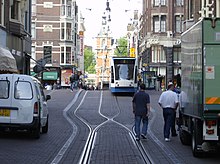
Back عمران موجه نحو النقل العام Arabic توسعه ترانزیتمحور Persian Transit-oriented development French פיתוח מוטה תחבורה ציבורית HE Տարանցիկ-կողմնորոշված նախագծում Armenian Pembangunan berorientasi transit ID Transit-oriented development Italian 公共交通指向型開発 Japanese 대중교통 지향 개발 Korean Pembangunan berorientasikan transit Malay

In urban planning, transit-oriented development (TOD) is a type of urban development that maximizes the amount of residential, business and leisure space within walking distance of public transport.[1][2] It promotes a symbiotic relationship between dense, compact urban form and public transport use.[3] In doing so, TOD aims to increase public transport ridership by reducing the use of private cars and by promoting sustainable urban growth.[4]
TOD typically includes a central transit stop (such as a train station, or light rail or bus stop) surrounded by a high-density mixed-use area, with lower-density areas spreading out from this center, serving as part of an integrated transport network. TOD is also typically designed to be more walkable than other built-up areas, by using smaller block sizes and reducing the land area dedicated to automobiles.[5][6] Areas that center a transit station as a hub while building residential-focused TOD development in the immediate area are known as transit villages.
The densest areas of TOD are normally located within a radius of 1⁄4 to 1⁄2 mile (400 to 800 m) around the central transit stop, as this is considered to be an appropriate scale for pedestrians, thus solving the last mile problem.
- ^ Calthorpe, Peter (1993). The Next American Metropolis: Ecology, Community, and the American Dream. New York: Princeton Architectural Press. ISBN 9781878271686.
- ^ Cervero, Robert; et al. (2004). Transit Oriented Development in America: Experiences, Challenges, and Prospects. Washington: Transit Cooperative Research Program, Report 102. ISBN 978-0-309-08795-7. [1] Archived February 6, 2021, at the Wayback Machine
- ^ Caves, R. W. (2004). Encyclopedia of the City. Routledge. p. 676. ISBN 978-0415862875.
- ^ Robert Cervero, Chris Ferrell and Steven Murphy (2002). Transit-Oriented Development and Joint Development in the United States: A Literature Review, Research Results Digest Number 52, Transit Cooperative Research Program.
- ^ "Transit-Oriented Development (TOD)". www.sustainablecitiesinstitute.org. Archived from the original on December 20, 2016. Retrieved December 15, 2016.
- ^ "What is TOD?". Institute for Transportation and Development Policy. July 24, 2014.
